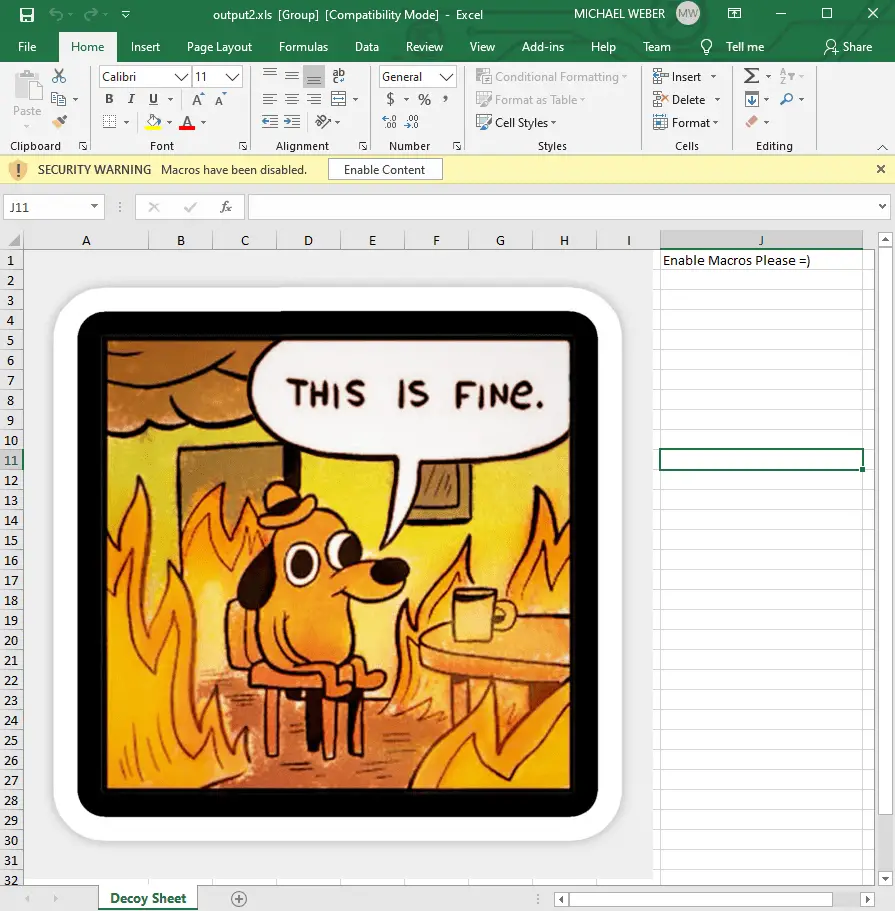Macrome v0.5.1 releases: Excel Macro Document Reader/Writer for Red Teamers & Analysts

Macrome
An Excel Macro Document Reader/Writer for Red Teamers & Analysts. A corresponding blog post describing what this tool actually does can be found here. Macrome also provides functionality that can be used to reverse many of these obfuscations in support of malware analysts and defenders. The tool was originally going to include functionality to process macros to help bypass obfuscated formulas, but @DissectMalware has already created a fantastic tool called XLMMacroDeobfuscator which goes above and beyond anything I was planning on dropping.
Usage
Run Macrome by either using dotnet run from the solution directory or dotnet against the built Macrome binary. There are two modes of operation for Macrome – Build mode and Deobfuscation mode.
Build Mode
Run Macrome with the build command in order to generate an Excel document containing an obfuscated macro sheet using a provided decoy document and macro payload. dotnet Macrome.dll build -h will display full usage instructions.
For example, to build a document using a decoy document path/to/decoy_document.xls and binary x86 shellcode stored at path/to/shellcode.bin, run dotnet Macrome.dll build –decoy-document path/to/decoy_document.xls –payload /path/to/shellcode.bin. This will generate an XLS 2003 document which after being opened and having the “Enable Content” button pressed, will execute the shellcode of shellcode.bin.
Binary Payload Usage
First generate a base “decoy” Excel document that will contain content users should see. This should be some sort of lure that convinces users to click the “Enable Macros” button displayed in Excel. There are some examples of the “latest and greatest” lure creation at https://inquest.net/blog/2020/05/06/ZLoader-4.0-Macrosheets-. Once this sheet is created, save the document as a type Excel 97-2003 Workbook (*.xls) rather than the newer Excel Workbook (*.xlsx) format. An example decoy document is included in /Docs/decoy_document.xls.
Next, generate a shellcode payload to provide to the tool. The example binary payload (which pops calc) was generated using msfvenom using the following parameters:
msfvenom -a x86 –platform windows -p windows/exec cmd=calc.exe -e x86/alpha_mixed -f raw EXITFUNC=thread > popcalc.bin
Note that using a majority alpha-numeric payload will reduce the size of the macro file generated since it’s easier to express letters and numbers in macro form instead of appending CHAR function invocations repeatedly like =CHAR(123)&CHAR(124)&CHAR(125)… etc. But the tool should be able to handle a completely unprintable binary payload as well.
Currently this will only work with x86 payloads, but x64 support is coming soon, along with support for loading .NET binaries.
Macro Payload Usage
Similar to binary payload usage, a decoy document must first be generated. Next, a text file containing the macros to run should be created. Macros should be separated by newline characters and will be written to column B starting with row 1. A basic example of a macro is provided in /Docs/macro_example.txt.
Finally, run the command:
dotnet Macrome.dll build –decoy-document decoy_document.xls –payload macro-example.txt –payload-type Macro
Note the usage of the payload-type flag set to Macro.
Deobfuscate Mode
Run Macrome with the deobfuscate command to take an obfuscated XLS Binary document and attempt to reverse several anti-analysis behaviors. dotnet Macrome.dll deobfuscate -h will display full usage instructions. Currently, by default this mode will:
- Unhide all sheets regardless of their hidden status
- Normalize the manually specified labels for all Lbl entries which Excel will interpret as Auto_Open entries despite their name not matching that string.
For example, to deobfuscate a malicious XLS 2003 macro file at path/to/obfuscated_file.xls, run dotnet Macrome.dll deobfuscate –path path/to/obfuscated_file.xls. This will generate a copy of the obfuscated file which will be easier to analyze manually or with tools.
Changelog v0.5.1
- bug fixes
Download
Copyright (c) 2020 Michael Weber





